Overview
In today’s fast-paced world, many entrepreneurs struggle with the challenge of crafting an effective elevator pitch. We understand how daunting it can feel to make a lasting first impression, especially when opportunities are on the line. This article emphasizes the significance of a well-crafted pitch, not just as a tool for communication, but as a way to connect with others and open doors to new possibilities.
To help you navigate this journey, we provide a step-by-step guide for developing a concise and engaging presentation. Clarity is key—your message should resonate with your audience, capturing their attention and interest. We encourage you to reflect on your own experiences: have you ever felt lost in a conversation? By being aware of your audience, you can tailor your pitch to meet their needs, fostering a deeper connection.
Practice is essential to enhance your communication skills. With each attempt, you build confidence and refine your message. Remember, you are not alone in this process; many have faced similar hurdles and emerged stronger. Embrace the opportunity to grow and learn, and let this guide empower you in your journey toward effective self-presentation.
As you work on your elevator pitch, consider the emotional impact of your words. Your story matters, and sharing it authentically can inspire others. We invite you to take action—start crafting your pitch today, and watch as it transforms not only your professional interactions but also your career ownership.
Introduction
In the competitive world of entrepreneurship, we understand that the ability to effectively communicate your business idea can be the difference between success and obscurity. This is where the elevator pitch comes in—an essential tool that empowers you to succinctly convey your vision in just a matter of seconds. As the landscape of startups evolves and investor expectations rise, crafting a compelling elevator pitch has never been more critical.
This article delves into the art and science of the elevator pitch, exploring its significance and the common pitfalls to avoid. We will provide you with practical steps to create a memorable message that resonates with potential investors and partners alike. With insights from experts and real-world examples, you are not alone in navigating your career transitions; you will be equipped to seize opportunities in an ever-changing economy.
Understanding the Elevator Pitch: A Key Tool for Entrepreneurs
A brief and persuasive speech is designed to spark interest in your business or organization. Typically lasting between 30 to 60 seconds, it should be concise enough to deliver during a short lift ride. The primary goal is to communicate your message clearly and compellingly, ensuring it resonates with your audience.
This tool is especially vital for elevator pitch entrepreneurs and individuals navigating transitions who must quickly articulate their business idea, product, or service to potential investors, clients, or partners. This is particularly important in the context of overcoming the challenges posed by the Battered Career Syndrome® and Investor Syndrome®.
The importance of a well-prepared sales presentation cannot be overstated; it serves as a gateway to opportunities and fosters meaningful discussions. As we look toward 2025, the landscape of brief presentations has evolved, reflecting shifts in the startup ecosystem and a changing career economy. With reduced startup launch costs and heightened investor expectations for proof of concept, entrepreneurs are encouraged to adopt a ‘show, don’t tell’ approach.
This shift emphasizes transparency and the use of asynchronous pitching methods, allowing for more effective presentations that can reach a broader audience. The development of succinct presentations highlights the necessity for elevator pitch entrepreneurs to adjust their communication strategies to align with these trends, ultimately enhancing their employability and personal agency.
Current expert views emphasize that a compelling self-presentation is crucial for networking success. Many elevator pitch entrepreneurs recognize the need to have a basic presentation ready for unexpected opportunities, reinforcing the importance of preparation. Regular practice and keeping business cards handy are recommended strategies to ensure you are always ready.
As Leslie A. Caromile insightfully states, “By adhering to the guidelines provided here, scientists can develop a concise presentation that showcases their distinct identity and makes a memorable impact on the audience.” This insight underscores the significance of authenticity in crafting effective proposals, which is essential for those pursuing financial freedom and a successful transition to business ownership.
Statistics indicate that a considerable number of entrepreneurs actively employ concise presentations in networking situations, highlighting their effectiveness. The Entrepreneur’s Source has supported hundreds of thousands in evaluating their career options, emphasizing the importance of concise presentations during career changes—especially for individuals looking to take charge of their professional paths.
To create a memorable elevator pitch entrepreneur presentation, it’s essential to focus on clarity, brevity, and engagement. Start by defining your core message, then refine it to ensure it captures attention quickly. Incorporating recent trends and examples from successful startups can further enhance your presentation, making it relevant and compelling in today’s dynamic business environment.
For more insights and strategies, download your free Veteran Entrepreneur® Program presentation here. Remember, with guidance from Find Your Career 2.0 | Career Ownership Coach Parnell Woodard, you can navigate your career transition effectively.
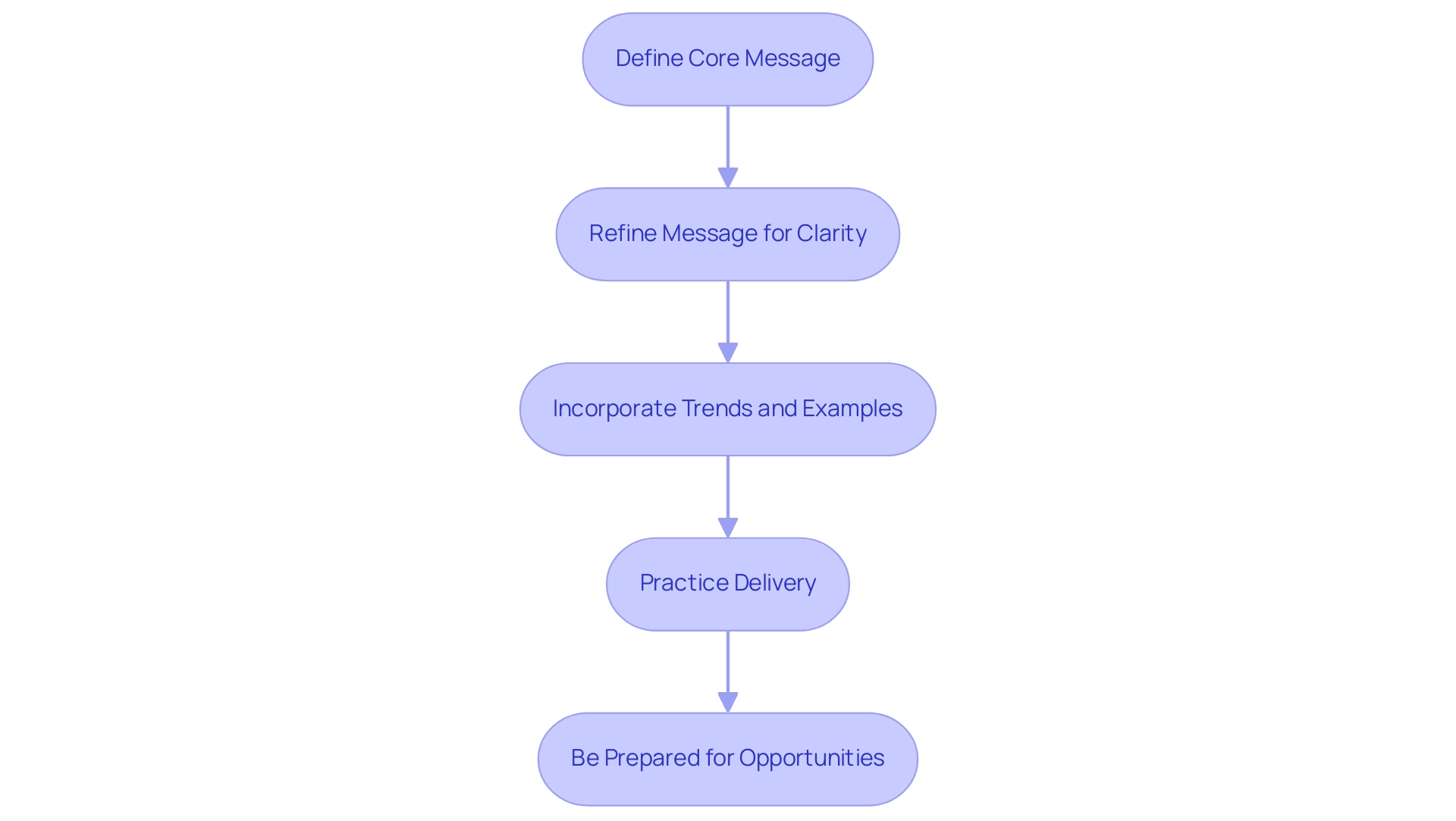
The Importance of an Elevator Pitch in Entrepreneurship
A concise presentation is essential for entrepreneurs, serving as a pivotal first impression that can significantly influence a prospective investor’s or client’s interest. This brief yet impactful presentation empowers entrepreneurs to clearly articulate their business idea, highlighting its unique features and the specific problems it addresses. In today’s competitive landscape, a persuasive introduction not only sets you apart from competitors but also opens doors for further discussions and opportunities.
Effective communication within your presentation is crucial, as it demonstrates your ability to engage early adopters and attract talent. Did you know that a staggering 70% of investors are swayed by the quality of a brief presentation? This statistic underscores the importance of this skill in securing funding and support. Moreover, case studies reveal that first impressions made during these brief encounters can profoundly affect investor interest, often determining whether they decide to delve deeper into your business.
As we look ahead to 2025, the focus on crafting a strong elevator pitch remains vital for those navigating the complexities of Battered Professional Syndrome and Investor Syndrome. “Your Profession 2.0: A Survival Guide for The Battered Profession Syndrome and Investor Syndrome” is an invaluable resource for those transitioning careers, guiding them toward business ownership and financial freedom. The Entrepreneur’s Source has empowered hundreds of thousands to explore their career options, illustrating the effectiveness of a structured approach to career transitions.
Leslie A. Caromile wisely notes that following structured guidelines can help individuals create proposals that resonate with their unique identity and leave a lasting impression. By concentrating on how your venture adds value to your audience, you not only enhance your chances of success but also position yourself as a credible and compelling candidate in the entrepreneurial ecosystem. This clarity and confidence, cultivated through comprehensive coaching, are crucial for delivering an impactful presentation.
Get the Book.
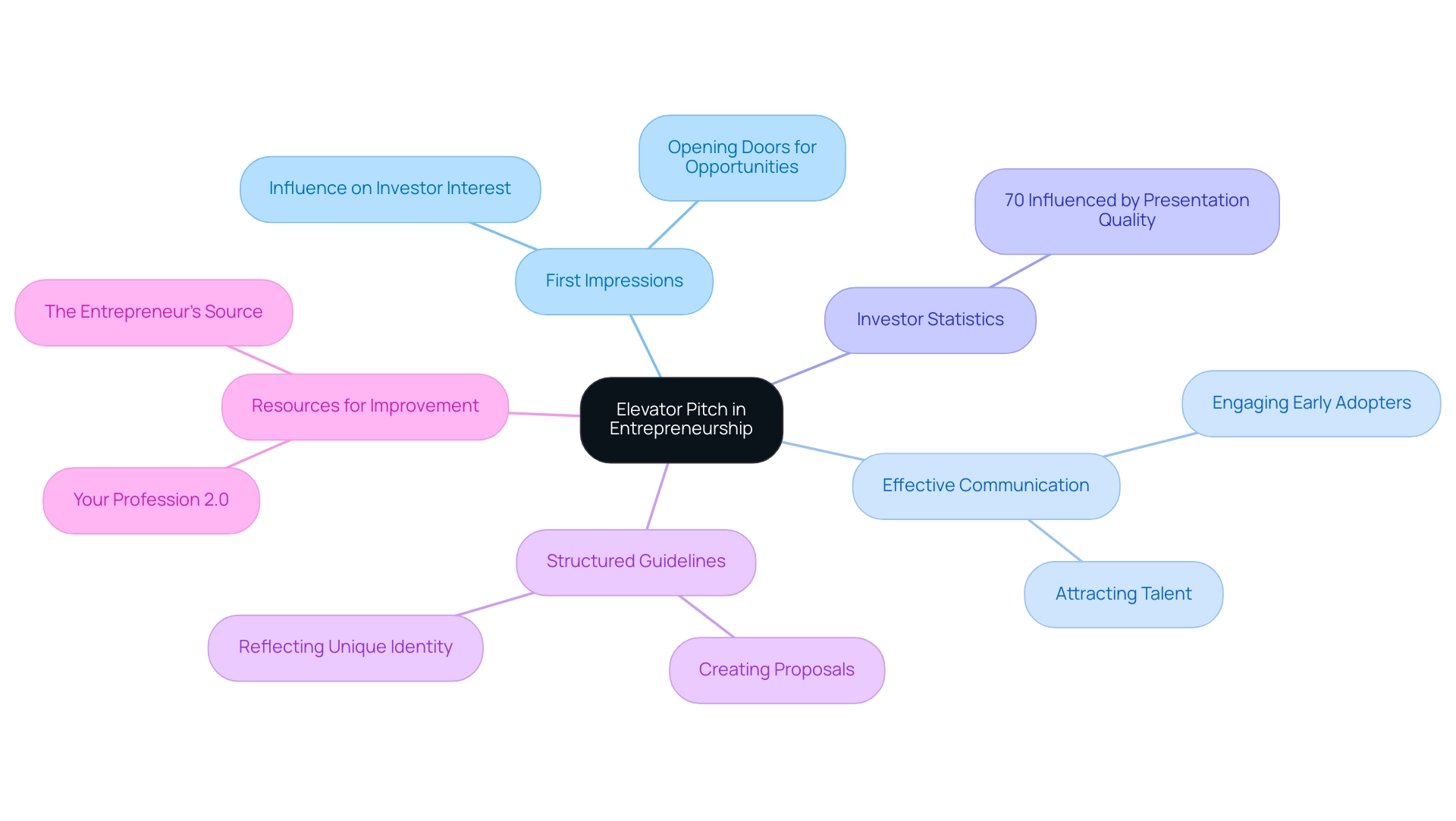
When and Where to Use Your Elevator Pitch
Elevator presentations serve as powerful tools in a multitude of professional scenarios, including networking events, conferences, meetings with potential investors, and even casual encounters with new contacts. We understand that the core of an effective promotional message rests in being ready to present it at a moment’s notice. Imagine engaging with someone at a networking event who shows interest in your business; having a well-crafted elevator introduction ready can leave a lasting impression and help you navigate the challenges of the current job market.
In job interviews, your elevator introduction can succinctly convey your unique value proposition, making it easier for interviewers to understand what sets you apart from other candidates. Similarly, when introducing yourself in professional settings, a clear and confident presentation can effectively communicate your goals and aspirations. This aligns with the principles outlined in ‘Your Career 2.0: A Survival Guide for The Battered Career Syndrome and Investor Syndrome’ by Find Your Career 2.0 | Career Ownership Coach Parnell Woodard. This guide serves as a transformative resource for those looking to take control of their career paths through business ownership.
Best practices for utilizing concise presentations in networking events include customizing your message for your audience and rehearsing your delivery to boost confidence. Have you ever thought about how crucial networking is for job searches and business leads? Research indicates that yet a significant portion of professionals—one in four—do not engage in networking at all. This underscores the importance of being prepared to seize opportunities when they arise, especially in a declining job market where employability and transferable skills are paramount.
As Sean Wise, a best-selling author and venture capitalist, states, ‘This is the greatest opportunity these investors will see,’ emphasizing the significance of creating a strong impression.
Real-life instances show that entrepreneurs, often referred to as elevator pitch entrepreneurs, frequently utilize concise presentations in job interviews, resulting in successful outcomes. The case study titled ‘Creating Your Winning Elevator Presentation’ offers a step-by-step guide for the elevator pitch entrepreneur on crafting a presentation, including identifying goals, defining the audience, outlining the value proposition, and practicing the delivery. By understanding the best situations to present your proposal and preparing thoroughly, you can maximize your chances of making a positive impact.
Remember, confidence in your message not only enhances its effectiveness but also encourages others to believe in your vision. Additionally, keep in mind that the preferred-rate application deadline for the 2025 Inc. 5000 is March 21 at 11:59 p.m. PT, which adds a sense of urgency for those elevator pitch entrepreneurs looking to elevate their business.
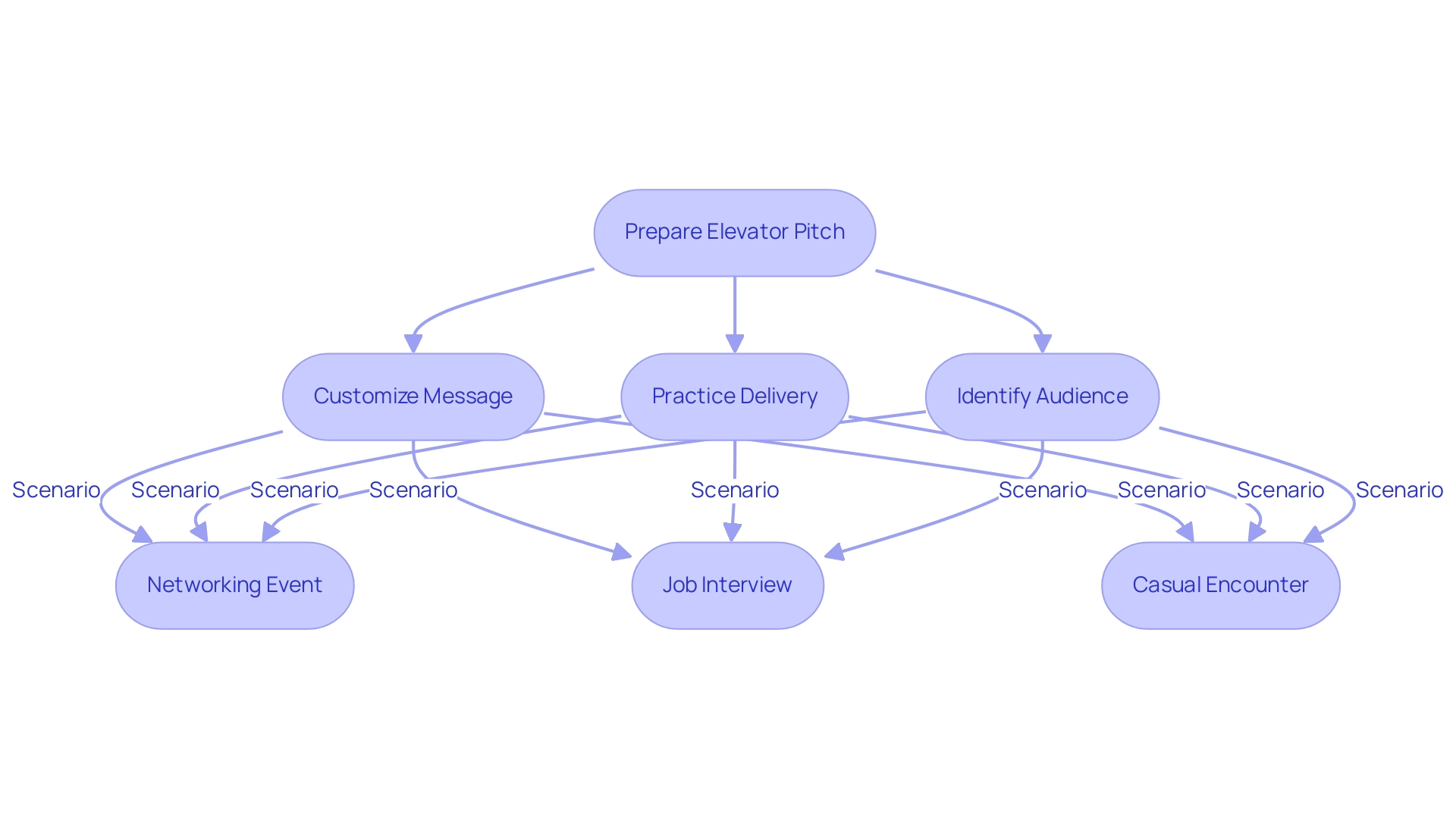
Step-by-Step Guide to Crafting Your Elevator Pitch
Creating an effective elevator pitch entrepreneur presentation is essential for those navigating career transitions. We understand that making a lasting impression can be challenging. Follow these steps to craft a compelling pitch that resonates with your audience:
- Identify Your Goal: Begin by clarifying your objectives. Are you seeking investment, partnerships, or simply raising awareness about your business?
- Know Your Audience: Tailor your pitch to align with your audience’s interests and needs. Understanding their values helps you connect on a deeper level.
- Start with a Hook: Capture attention immediately with an engaging statement or question that sparks curiosity.
- Describe Your Business: Clearly articulate what your business does, emphasizing the specific problem it addresses and your unique solution. This clarity is especially vital for those transitioning from traditional professions, as it highlights the personal agency you can take in shaping your future.
- Highlight Your Value Proposition: Distinguish your business from competitors by clearly stating what sets you apart and why it matters to your audience. The Entrepreneur’s Source has empowered hundreds of thousands in evaluating their options, underscoring the significance of a strong value proposition in achieving financial freedom and stability.
- End with a Call to Action: Conclude with a specific request, such as scheduling a follow-up meeting or inviting feedback. Consider exploring ‘Your Professional Path 2.0: A Survival Guide for The Battered Professional Syndrome and Investor Syndrome’ for further insights and strategies to support your transition.
Research indicates that customized presentations significantly enhance engagement and interest. For instance, participants in the Accelerating Transitions (ACT) Program reported increased confidence and expanded professional networks after honing their elevator pitch skills. This demonstrates how a well-crafted message can positively impact your professional journey. As Parnell Woodard, a Professional Ownership Coach, shares, “I chose a profession in project management because I had a passion for it, and now I can proudly say that I’ve been able to make a real difference in people’s lives.”
By following these steps, you can effectively communicate your vision and foster meaningful connections, aligning with the comprehensive and personalized approach to professional coaching offered by Find Your Career 2.0. Remember, you are not alone in this journey; we are here to support you every step of the way.
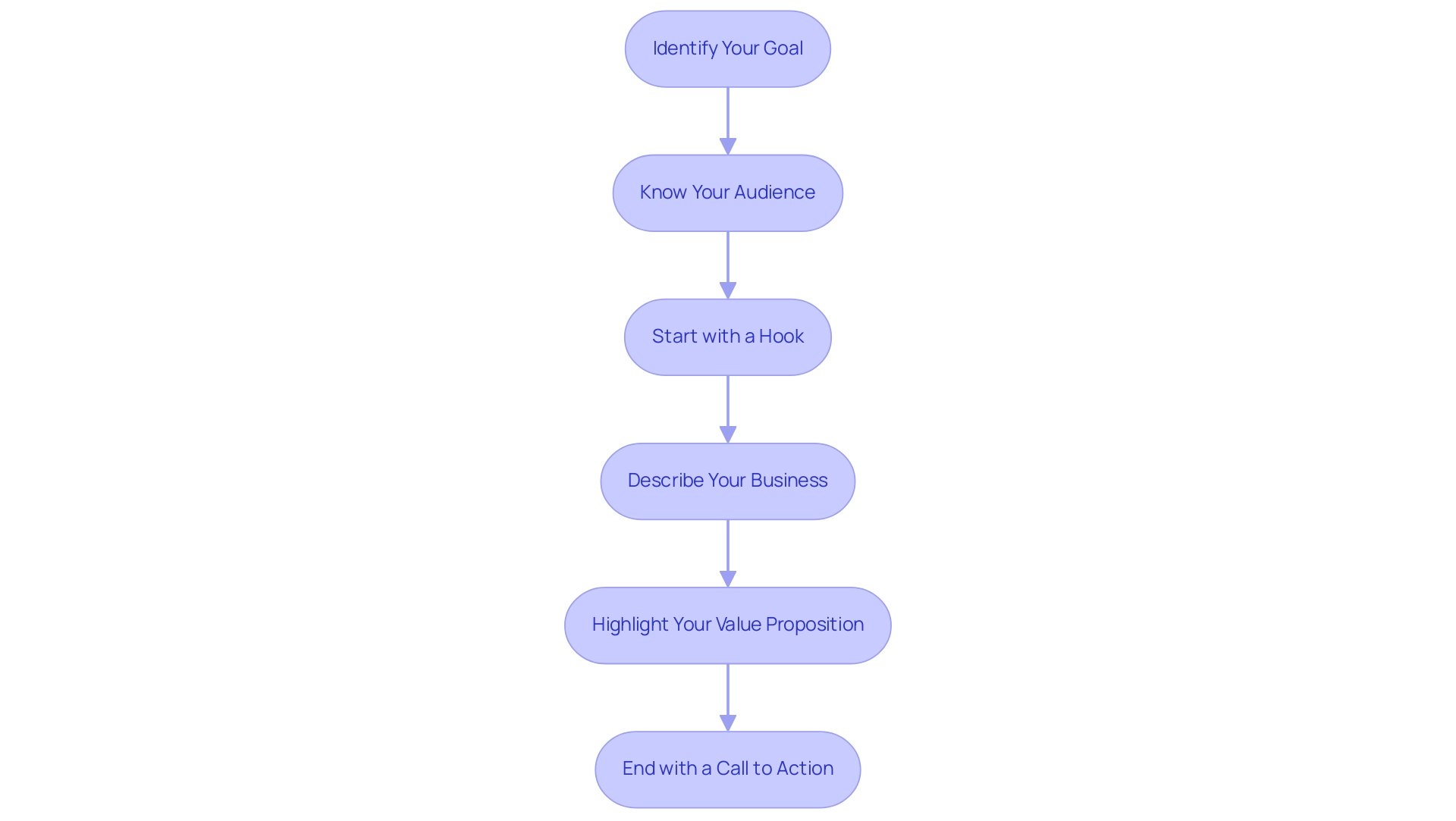
Delivering Your Elevator Pitch Effectively: Tips and Techniques
To effectively deliver your elevator presentation, it’s essential to consider strategies that not only navigate career challenges but also foster your journey toward financial independence and personal agency. We understand that this can be daunting, yet you are not alone in this process.
- Practice Regularly: Rehearsing your presentation multiple times is vital for building confidence and ensuring a smooth delivery. Studies show that consistent practice can enhance the effectiveness of your presentation, with individuals reporting a 30% increase in clarity and engagement. Recognizing your transferable skills is equally important; only 10% of employees have a skills database, underscoring the need for clarity and preparation in presenting your case. This aligns with the principles in ‘Your Career 2.0: A Survival Guide for The Battered Career Syndrome and Investor Syndrome,’ which emphasizes the importance of taking control of your career.
- Adopt a Conversational Tone: Strive for a natural, conversational style rather than a robotic recitation. Engaging your audience through eye contact and appropriate body language fosters a connection, making your presentation more memorable and empowering you as you transition into business ownership.
- Control Your Pace: Speaking clearly and at a moderate pace allows your audience to absorb your message effectively. A measured delivery enhances comprehension and retention, making your presentation more impactful, especially in a challenging job market.
- Exude Enthusiasm: Your passion for your business should shine through. Research indicates that enthusiasm can significantly impact audience engagement; 70% of listeners are more likely to recall a presentation delivered with genuine excitement. This emotional connection can be a powerful tool in capturing interest, reinforcing your personal agency in your professional journey.
- Prepare for Questions: Anticipate inquiries from your audience after your presentation. Being ready to provide additional information or clarify points demonstrates your expertise and commitment, further solidifying their interest in your venture. The ACT program, which emphasizes moving into faculty and research positions, illustrates how effective communication and networking can improve job transitions.
By applying these techniques, you can refine your elevator pitch and enhance your professional presence as you navigate your transition. The insights from ‘Your Career 2.0’ can support you in this journey, ensuring you gain clarity and confidence in your vocational decisions. For further guidance, consider the resources offered by Find Your Career 2.0 | Career Ownership Coach Parnell Woodard.
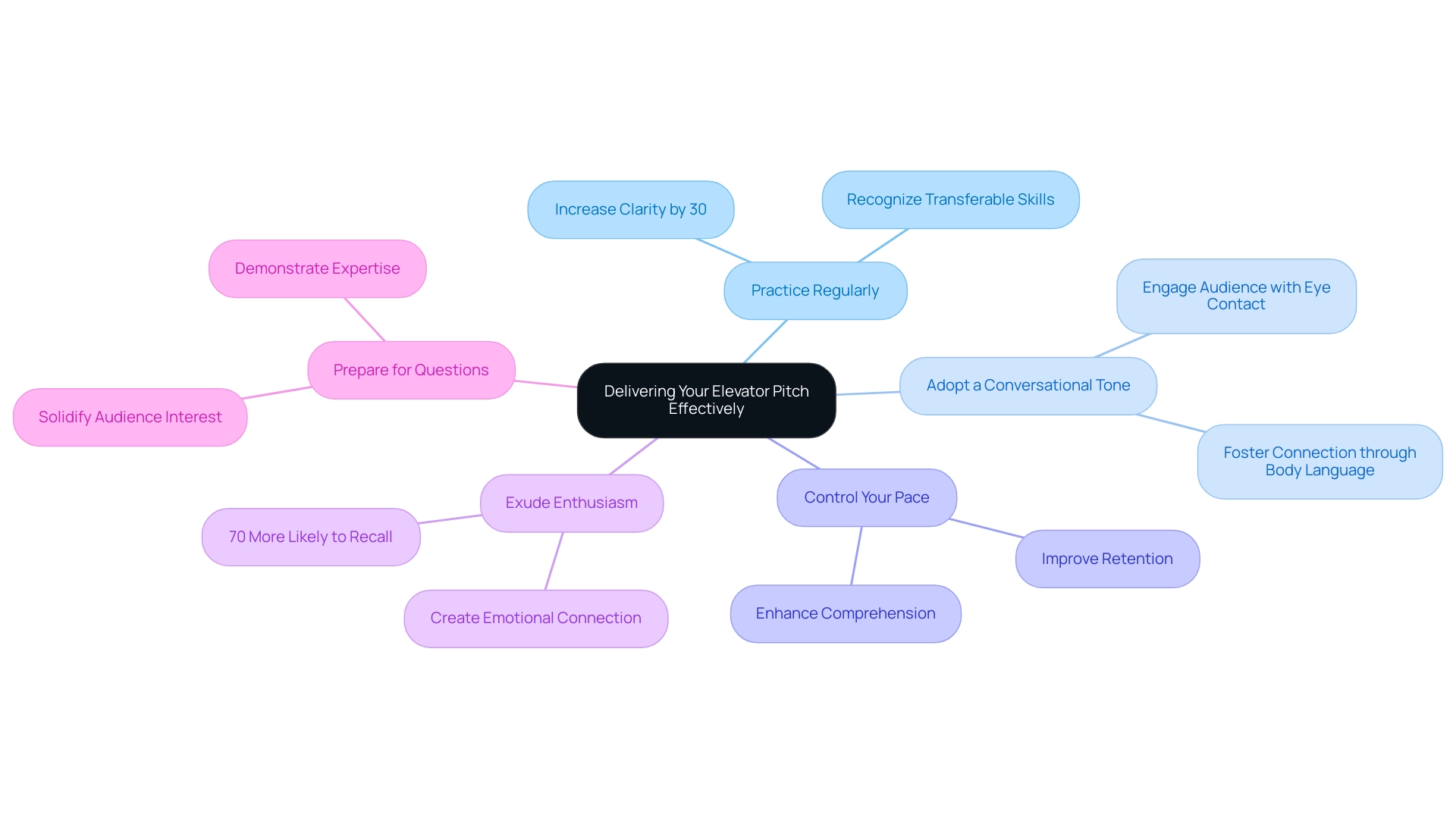
Common Mistakes to Avoid When Crafting Your Elevator Pitch
When crafting your elevator pitch, it’s essential to be mindful of common pitfalls that can hinder your success:
-
Being Too Vague: Generic statements often fail to convey your business’s unique value. Instead, focus on specific aspects that set your offering apart. Research shows that audiences retain information better when presentations are clear and concise, making specificity crucial. In today’s challenging job market, where employability can feel uncertain, clarity in communication becomes even more vital. The Entrepreneur’s Source has helped countless individuals evaluate their professional possibilities, highlighting the importance of articulating your unique value proposition with clarity.
-
Overloading with Information: A concise presentation is far more effective. Overwhelming your audience with too much information can lead to disengagement. Strive for clarity and brevity to maintain their interest, especially as many are navigating job transitions and seeking financial freedom as elevator pitch entrepreneurs.
-
Neglecting the Audience: It’s important to customize your presentation to resonate with your audience’s interests and needs. A one-size-fits-all approach often misses the mark, as effective communication requires an understanding of your listeners’ perspectives. In the context of career ownership and personal agency, recognizing the aspirations of your audience can make your presentation more impactful.
-
Failing to Practice: Confidence in delivery comes from practice. By rehearsing your presentation, you not only enhance your comfort level but also refine your message. Participating in practice sessions with peers can provide valuable insights, as highlighted in the case study ‘Rehearsing and Refining Your Presentation,’ which demonstrates that diligent practice leads to a stronger and more persuasive delivery.
-
Ignoring Feedback: Constructive criticism is a vital tool for improvement. Embrace feedback to enhance your presentation, making it more compelling and effective. As Belinda Huckle, Co-Founder and Managing Director of Second Nature International, emphasizes, individuals don’t need to change who they are to become effective presenters; they simply need to refine their approach. This reinforces the idea that feedback is essential for creating a successful proposal, especially for individuals facing the challenges of Battered Professional Syndrome and Investor Syndrome.
By being aware of these pitfalls and actively working to avoid them, you can create a concise presentation that not only captures attention but also leaves a lasting impression. This empowers you to take control of your career and financial destiny. For further insights on navigating these challenges, consider exploring ‘Your Career 2.0: A Survival Guide for The Battered Career Syndrome and Investor Syndrome’ by Find Your Career 2.0 | Career Ownership Coach Parnell Woodard.
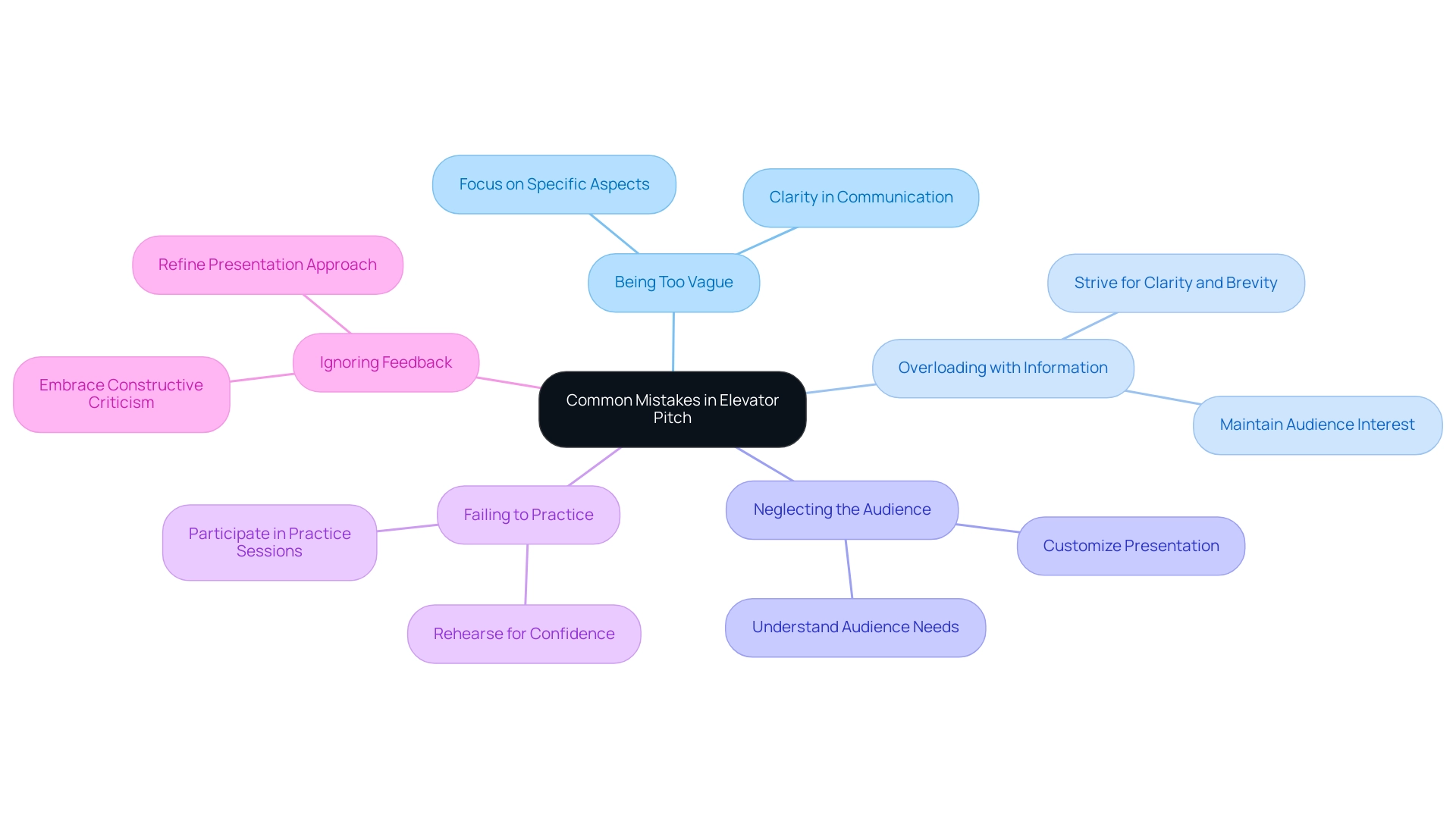
Next Steps After Your Elevator Pitch: Building Connections
After delivering your elevator pitch, taking strategic next steps is crucial for building lasting connections, especially in today’s rapidly changing economy. We understand that navigating this landscape can feel daunting, but there are effective strategies you can consider to foster these relationships:
- Follow Up Promptly: Within 24 hours, send a thank-you email or message to express your appreciation for their time. This not only reinforces your interest but also keeps the conversation fresh in their mind. As Brad Feld wisely stated, “I don’t want to hear you describe what you are going to do, I want to see it,” highlighting the importance of demonstrating your intentions through action. In a professional landscape where positions are increasingly short-lived, timely follow-ups can set you apart and show your commitment to building meaningful connections.
- Leverage Social Media: Connecting on platforms like LinkedIn can be a powerful way to maintain and strengthen your relationship. Research indicates that 70% of professionals believe social media is essential for networking, making it a vital tool for ongoing engagement. This is especially important for individuals transitioning between jobs, as they navigate employability challenges in a declining job economy. Remember, you are not alone in this journey.
- Share Additional Information: Offer to provide more details about your business or answer any questions they may have. This demonstrates your willingness to engage further and can lead to deeper discussions. For example, effective follow-up strategies can significantly improve networking results; a study revealed that individuals who follow up after networking events are 50% more likely to establish meaningful connections. This is essential for those pursuing financial freedom and new job opportunities.
- Propose a Meeting: If the initial conversation was positive, suggest scheduling a follow-up meeting. This can open doors to potential collaborations or investment opportunities, allowing both parties to explore synergies. Remember to maintain a professional appearance in online settings, ensuring proper camera angle, lighting, and minimal distractions during virtual meetings.
In 2025, experts emphasize that effective follow-up strategies can significantly enhance networking outcomes. By implementing these best practices, you can ensure that your elevator pitch leads to fruitful relationships and opportunities. The Entrepreneur’s Source has empowered hundreds of thousands of clients to evaluate their professional possibilities and enhance their lives through personalized coaching, making these strategies particularly relevant for transitioners seeking to take control of their futures.
At Find Your Career 2.0 | Career Ownership Coach Parnell Woodard, we encourage you to take control of your destiny and navigate the challenges of the current career landscape. Remember, you have the power to shape your future.
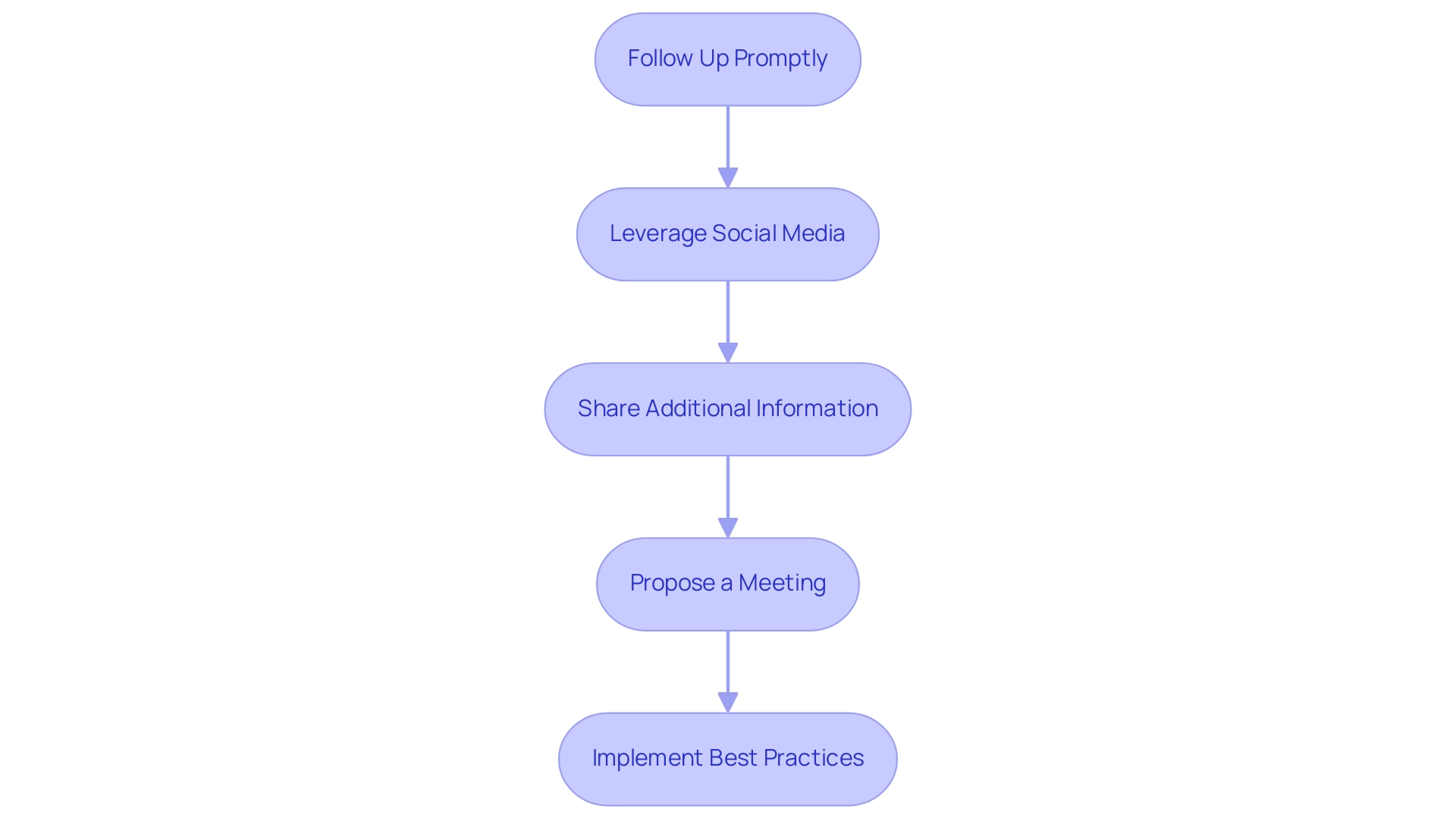
Conclusion
The significance of a well-crafted elevator pitch in entrepreneurship truly resonates. It is not merely a tool; it is a vital means of quickly and effectively communicating your business idea, capturing the attention of potential investors and partners. By focusing on clarity, brevity, and engagement, you can create pitches that deeply resonate with your audience and open doors to new opportunities.
However, common pitfalls, like being too vague or overwhelming with information, can detract from the effectiveness of your elevator pitch. We understand that avoiding these mistakes while honing your message is crucial. By doing so, you position yourself as a credible and compelling candidate in a competitive landscape. Regular practice and a conversational delivery not only enhance your pitch but also instill confidence, allowing you to convey your passion and vision effectively.
Ultimately, the elevator pitch is more than just a presentation; it serves as an entry point to meaningful connections and potential collaborations. By following up strategically after delivering your pitch, leveraging social media, and maintaining engagement, you can build lasting relationships that further your career transitions and business aspirations. In a rapidly evolving economy, mastering the art of the elevator pitch empowers you to take control of your future and navigate the challenges of entrepreneurship with confidence. Remember, you are not alone on this journey—embracing these strategies can lead you toward the success you aspire to achieve.
Frequently Asked Questions
What is an elevator pitch?
An elevator pitch is a brief and persuasive speech designed to spark interest in a business or organization, typically lasting between 30 to 60 seconds.
What is the primary goal of an elevator pitch?
The primary goal is to communicate your message clearly and compellingly, ensuring it resonates with your audience.
Who benefits from having a well-prepared elevator pitch?
Elevator pitch entrepreneurs and individuals navigating career transitions benefit from having a well-prepared pitch to quickly articulate their business idea, product, or service to potential investors, clients, or partners.
Why is a concise presentation important in today’s business landscape?
A concise presentation serves as a pivotal first impression that can significantly influence a prospective investor’s or client’s interest, opening doors for further discussions and opportunities.
What are some current trends in elevator pitches?
Current trends emphasize a ‘show, don’t tell’ approach, transparency, and the use of asynchronous pitching methods to reach a broader audience effectively.
What strategies can help entrepreneurs prepare for unexpected opportunities?
Regular practice, having a basic presentation ready, and keeping business cards handy are recommended strategies to ensure readiness for networking opportunities.
How does a compelling self-presentation impact networking success?
A compelling self-presentation is crucial for networking success, as it helps individuals engage early adopters and attract talent.
What percentage of investors are swayed by the quality of a brief presentation?
About 70% of investors are influenced by the quality of a brief presentation, highlighting its importance in securing funding and support.
What should entrepreneurs focus on when crafting their elevator pitch?
Entrepreneurs should focus on clarity, brevity, and engagement, defining their core message and refining it to capture attention quickly.
How can entrepreneurs enhance the relevance of their presentations?
Incorporating recent trends and examples from successful startups can enhance the relevance and compelling nature of their presentations.


